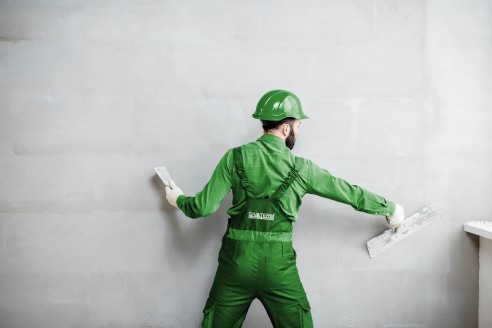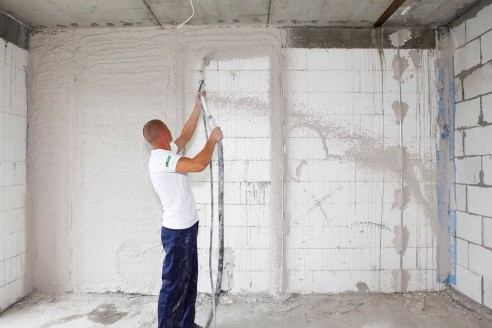.jpg)
Thermal insulation plasters, sheathing and insulation applications continue to increase day by day. In other words, insulation plasters are becoming more and more preferred products and their name is announced to more users. The fact that the users state that they are very satisfied with the thermal insulation plaster also increases the reliability of these materials.
On the other hand, despite the increasing usage rate and positive feedback, there are those who look at thermal insulation plasters with a question mark. Although these people accept the ease of application of sheathing with plaster, they are skeptical of its performance in thermal insulation. When they look at conventional boards, the idea that it can only be insulated with plaster seems distant to them.
In fact, since the subject is a technical subject, it is very easy to explain and prove it scientifically. There is a value called "Lamda Value", which shows the thermal insulation performance of objects. This value expressed in w/mK; It tells us how much heat insulation plaster, sheet or any object can do. As it can be understood from the unit expression, this value, which is obtained by dividing the amount of energy held by the meter, that is, the length, shows us that the thickness of the material is directly related to the subject. So, in summary, we can say that; Two objects with the same lambda value make the same thermal insulation when they are of the same thickness. Things like hardness, softness etc. will not affect this calculation at all. Again, based on these values, we can calculate the following. Suppose we have a 4 cm thick plate with x lambda value. We can calculate how thick the thermal insulation plaster should be in order to insulate the same with a plaster of lamda value.
To explain even more clearly; It is something that can be revealed with technical values whether a material can insulate or how much insulation it can make. Therefore, the thermal insulation of any material is a scientifically specified and measurable value. The subject has nothing to do with the structure, color, hardness, etc. of the material.
Let's get to the answer to our question. When we look at the lambda values, we can clearly say that thermal insulation plasters insulate. We can prove this statement as well. When we evaluate it with boards in terms of performance, we can see that there are thermal insulation plasters with far superior lambda values than boards. Moreover, if we take into account that the performance of insulated plasters does not melt or rot like boards, we can say that these materials are extra superior in the long run.
 Benefits of Thermal Insulation
Benefits of Thermal Insulation Thermal insulation is the process of heat transfer between insulating material and materials in contact with heat. Thermal insulation is measured by thermal conductivity. Low thermal conductivity materials are used for thermal insulation. In addition to thermal conductivity, density and heat capacity are also important properties of insulation materials.For thermal insulation, heat flow through the insulation material must be resisted. Therefore, the insulating material working as an i
 Exterior Sheathing Prices
Exterior Sheathing Prices In recent years, there has been a serious increase in the number of buildings benefiting from the application of exterior sheathing, together with the increasing energy costs and the support and obligations of the state in terms of insulation. Although this mobility in the sector was reflected positively on the prices at first, the fluctuations in the foreign currency caused the prices to increase again.While calculating the exterior sheathing prices, the main cost is labor and materia
 Importance of Internal Insulation
Importance of Internal Insulation Insulation in buildings can be done both inside and outside. As it is known, the application we call sheathing is the name given to the insulation made from the outside. It is even sometimes called exterior cladding or exterior sheathing. The biggest reason why the sheathing is done only from the outside is that the old type classical insulation materials contain carcinogenic substances because they are petroleum derivatives. Moreover, these materials are quite unstable. The last layer of pla
 Advantages of Using Thermal Insulation Plaster in Sheathing
Advantages of Using Thermal Insulation Plaster in Sheathing Sheathing is the covering of buildings with materials that provide thermal insulation from the outside. This process has taken this name because it resembles the process of dressing to protect our body in the cold of winter. In other words, when we say sheathing with thermal insulation plaster, we mean covering the building with thermal insulation plaster. The aim here is to make the interior of the building, namely our living spaces, least affected by the weather conditions outside. In this
.jpg) What are the General Properties of Thermal Insulation Materials?
What are the General Properties of Thermal Insulation Materials? Thermal insulation materials are used to prevent heat loss or to keep heat out. Almost all thermal insulation materials help to prevent the penetration of heat and radiant rays into the hot air and the flow of heat into the cold air. Mainly dependent on thermal conductivity, the most common thermal insulation materials include fiberglass foam. In addition to this, you can choose aerogelli plasterterm thermal insulation plaster, which is very popular recently. Sıvaterm 100% domestic productio